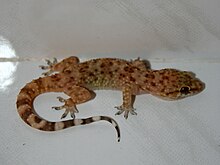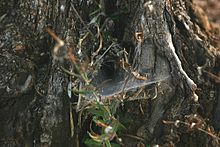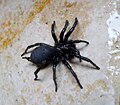Spanish funnel-web spider
| Spanish funnel-web spider | ||||||||||||
|---|---|---|---|---|---|---|---|---|---|---|---|---|

Spanish funnel- web spider ( Macrothele calpeiana ), female |
||||||||||||
| Systematics | ||||||||||||
|
||||||||||||
| Scientific name | ||||||||||||
| Macrothele calpeiana | ||||||||||||
| ( Walckenaer , 1805) |
The Spanish or European funnel- web spider ( Macrothele calpeiana ) is a web spider from the Macrothelidae family . The spider is one of the largest in Europe and is known for the effect of its bite.
features
The body length of the female can be up to 37 millimeters, that of the male up to 25 millimeters. The basic color of the Spanish funnel-web spider is black-brown with a purple sheen. The opisthosoma is a little lighter in color. The body structure corresponds to that of other species of the Macrothelidae family , which means that this species , which belongs to the tarantula- like species, appears comparatively primeval and robust and is also reminiscent of the distantly related tarantulas . Other peculiarities that also occur in other species of the family are the fine body hair and the greatly elongated spinnerets , which give the spider a significantly larger appearance. The anterior pair of spinnerets has receded here.
Similar species
The Spanish funnel-web spider is similar to other species in the family, including the much more prominent and also more dangerous Sydney funnel- web spider ( Atrax robustus ), which is common in Australia.
Occurrence
The range of the Spanish funnel-web spider includes two areas in Europe and Africa . In the last-mentioned continent it lives in Morocco and Algeria , in Europe the species inhabits a much smaller area in southern Spain and Portugal . It is also one of only two types of family found on the European continent. The other is the closely related species Macrothele cretica, which is endemic to Crete . The spider was introduced in the northern part of Italy and the species seems to be spreading in other parts of Europe as well, but is not building up stable populations. The species predominantly lives in shady areas, including cork oak and pine forests. Occasionally, suitable areas that have been remodeled by human hands are also adopted, including landfills.
Threat and protection
The Spanish funnel-web spider is the only spider species that is protected throughout Europe under the Fauna-Flora-Habitat Directive . The reason for this is the small area of distribution and the decline in their habitats.
Way of life
The Spanish funnel-web spider , like the other members of the family and similar to the not closely related angle spiders, builds a flatly spread out safety net that tapers towards the rear to form a funnel-shaped living tube. During the day the spider prefers to hide in this, but at night it likes to stay at the beginning of the tube mouth. The safety net is often placed on different trees and also at considerable heights. Catch nets were spotted, which were placed at a height of two meters. It is not uncommon to see other specimens' nets in the immediate vicinity. Various arthropods , which land on the net, are preferred as prey . As with other spiders that use a funnel net to catch prey, the Spanish funnel web spider comes out of its living tube as soon as a suitable prey animal lands on the net cover, grabs the prey with the chelicerae and then pulls itself with the prey into which poison has already been injected, back into the mesh tube to digest the prey there.
Reproduction

The reproductive behavior of the Spanish funnel-web spider has been studied but is not yet fully understood. If a female notices a male willing to mate on her net, she stands up and takes a position that resembles the typical threatening position. The male replies with the same gesture. This is so that both animals can adopt the mating position that is typical for tarantulas, which in the observed case occurred after about 30 seconds. In this, the male presses the tarsi and metatarsi of the first pair of legs against the sternum and the closed chelicerae of the female and the tibia as well as the metatarsi of the second pair of legs of the male against the femora of the second pair of legs of the female. It is believed that both sexual partners previously communicated with each other by means of stridulation . The male then led his bulbi into the female's Egipyne. The pairing took between 30 and 120 seconds in the investigations. The male then slowly separated from the female with his pedipalps raised and maintained body contact with the female with at least one leg of the front pair of legs before attempting to escape and being pursued by the female. The mating season of the Spanish funnel-web spider seems to coincide with the activity time of the males. It lasts from February to June. Females can be found all year round. From July onwards, females with egg cocoons and young animals were spotted in their own net in the wild . The cocoon of the Spanish funnel-web spider is round in shape, white in color, and about one centimeter in diameter. The cocoon is carried by the female with the chelicerae and is often held against the sunlight during the day. What was noticeable during observations was a stronger burial activity and a further expansion of the safety net of a female with a cocoon, which was supposed to serve to protect and deter ants. The young grow up in the mother's net before they become independent. Adult specimens of the Spanish funnel-web spider can be found all year round.
Natural enemies


The enemies of the Spanish funnel-web spider are vertebrates that prefer the same habitat, such as the European half-finger ( Hemidactylus turcicus ) or the blackbird ( Turdus merula ). The arthropods' predators would be other spiders of similar size, including some wolf spiders , or larger predatory insects such as fishing rods . The Spanish funnel- web spider is also occasionally attacked by parasitic mites of the genus Androlaelaps .
Bite accidents and toxicity
The Spanish funnel-web spider's bite is considered to be quite painful and can cause circulatory problems. Compared to other spiders, such as the Sydney funnel-web spider, the Spanish funnel-web spider is less dangerous. The aggressiveness of the species is also rather low, but increased aggressiveness can be observed in females guarding an egg cocoon. Should a specimen of the Spanish funnel-web spider feel threatened, it stands up and takes the threatening gesture typical of tarantulas (see picture of the threatening position). The spider can be bitten if provoked further.
Systematics
First describer Charles Athanase Walckenaer gave the Spanish funnel- web spider the name Mygale calpeiana in 1805 . Under Tord Tamerlan Teodor Thorell , the species was named Diplura calpeiana in 1870 . Anton Ausserer ran the Spanish funnel- web spider in 1871 under the name Macrothele calpetana and under the synonym Macrothele luctuosa . From 1986, Rowley G. Snazell established the current name Macrothele calpeiana .
See also
gallery
Individual evidence
- ↑ a b Species description of the Spanish funnel-web spider on ecotourismus.de ( Link )
- ↑ a b c d e Heiko Bellmann: The cosmos spider leader. Over 400 species in Europe. Kosmos Naturführer, Kosmos (Franckh-Kosmos), 2nd edition, 2016, p. 182, ISBN 978-3-440-14895-2 .
- ↑ a b c d e The Spanish funnel-web spider on the website of "araneae Spiders of Europe" ( Link )
- ↑ a b Description of the genus Macrothele on the website of the British Arachnological Society ( Link )
- ↑ Council Directive 92/43 / EEC
- ↑ Endangerment and protective measures of threatened European species in the field of biology on EUR-Lex (Council Directive 92/43 / EEC Link )
- ↑ a b c d e Species description of the Spanish funnel-web spider on the website of the British Tarantula Society Study Group ( Link )
- ↑ The Spanish funnel- web spider in the World Spider Catalog ( Link )
literature
- Heiko Bellmann: The cosmos spider guide. Over 400 species in Europe. Kosmos Naturführer, Kosmos (Franckh-Kosmos), 2nd edition, 2016, p. 182, ISBN 978-3-440-14895-2 .








